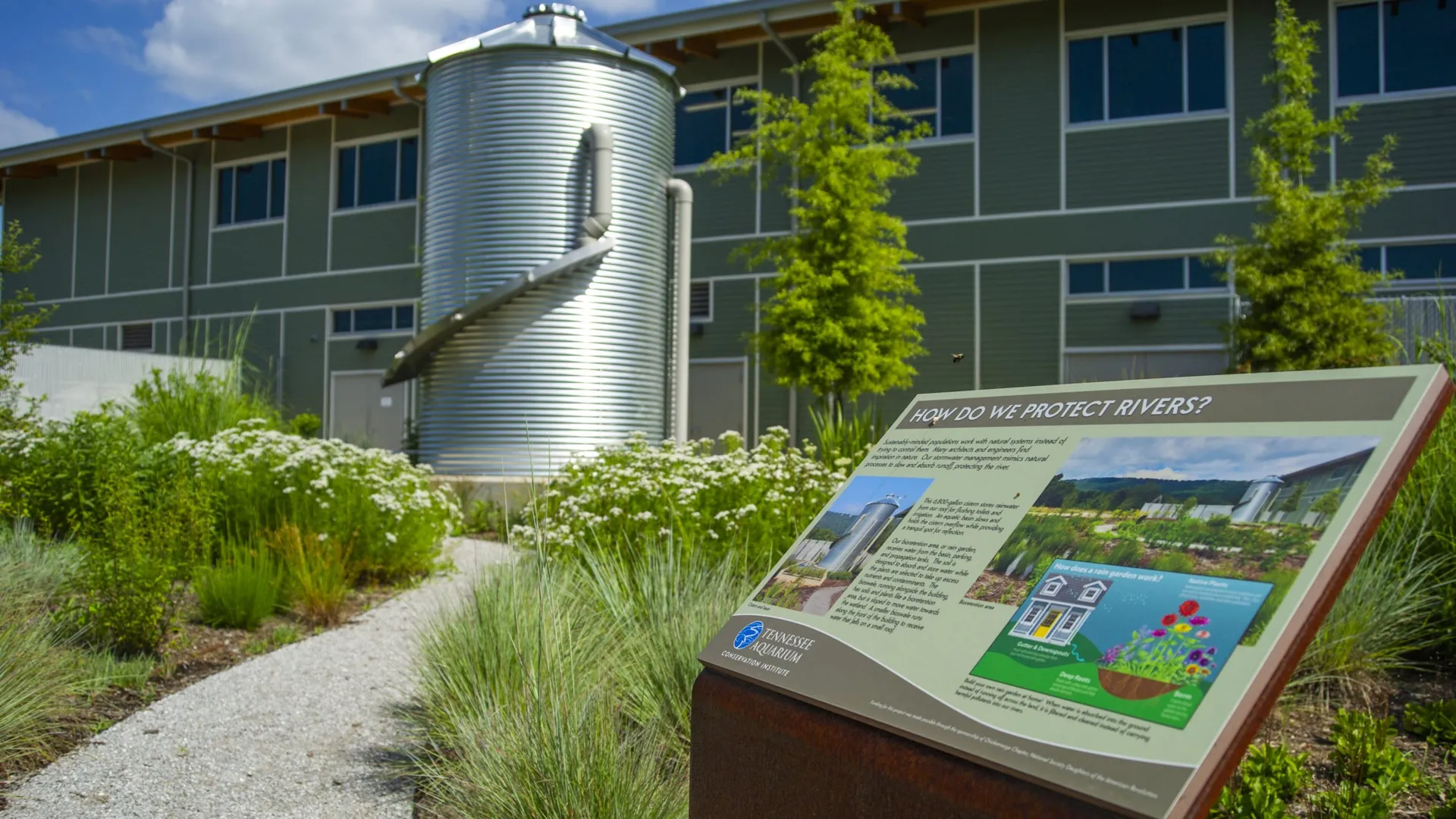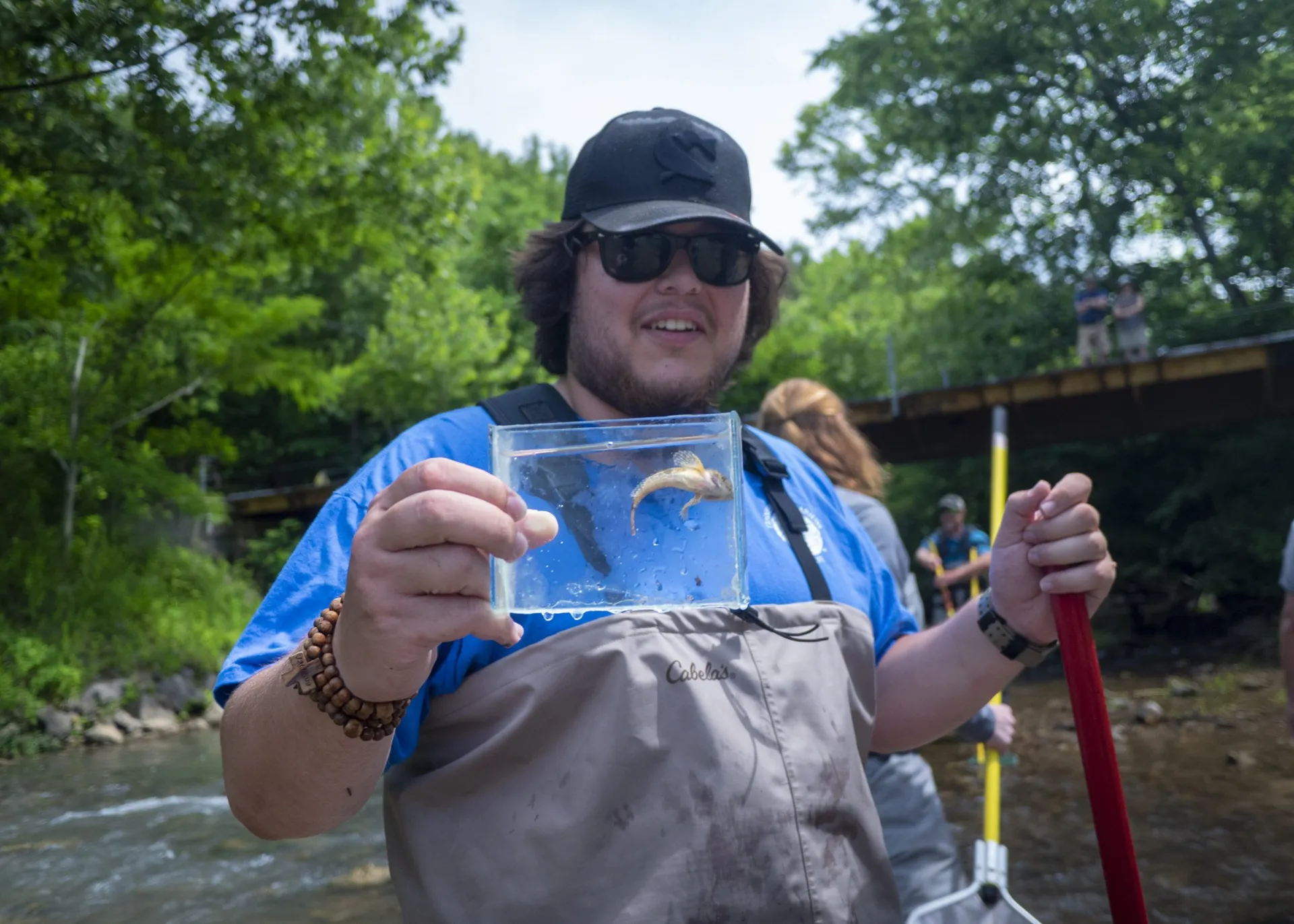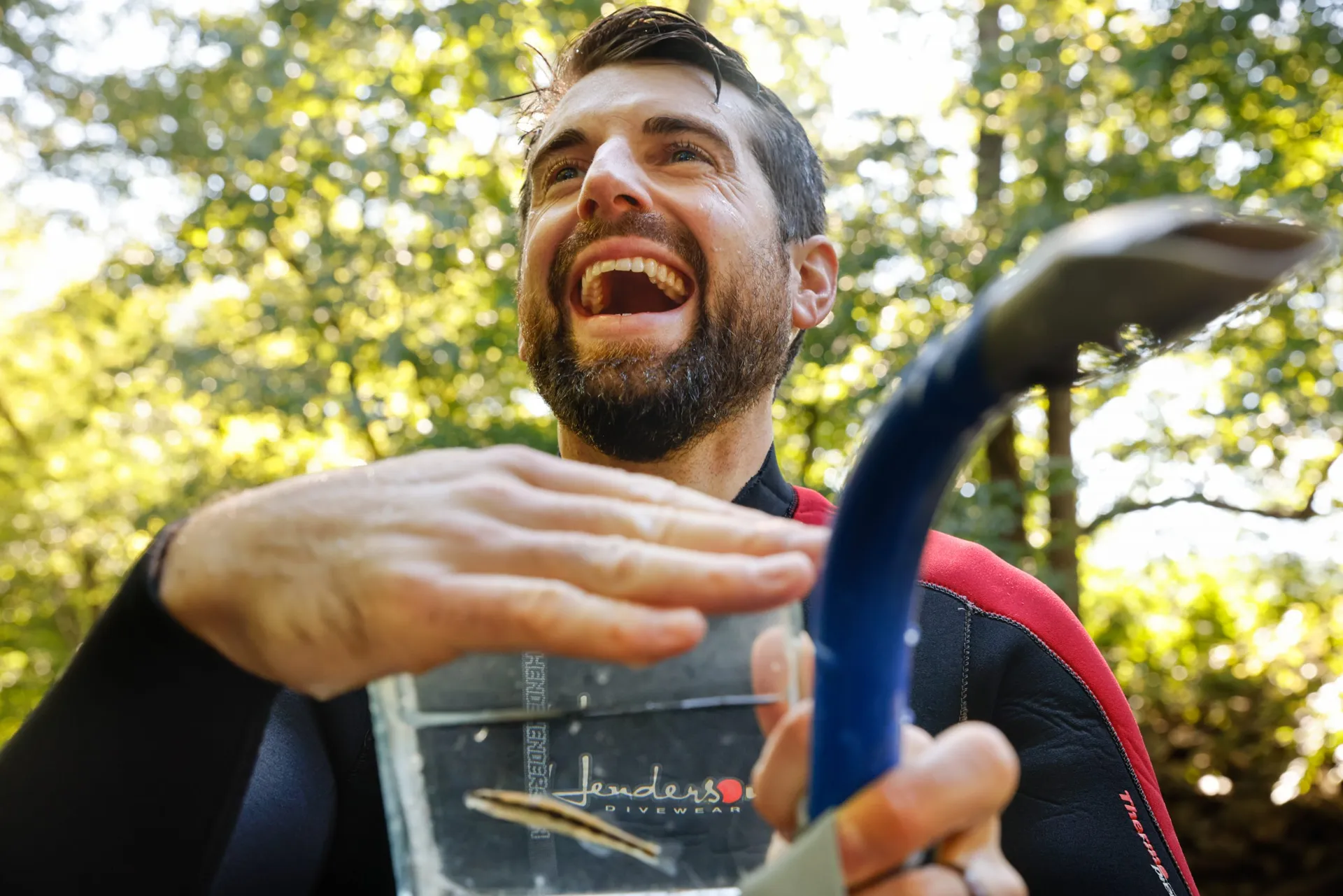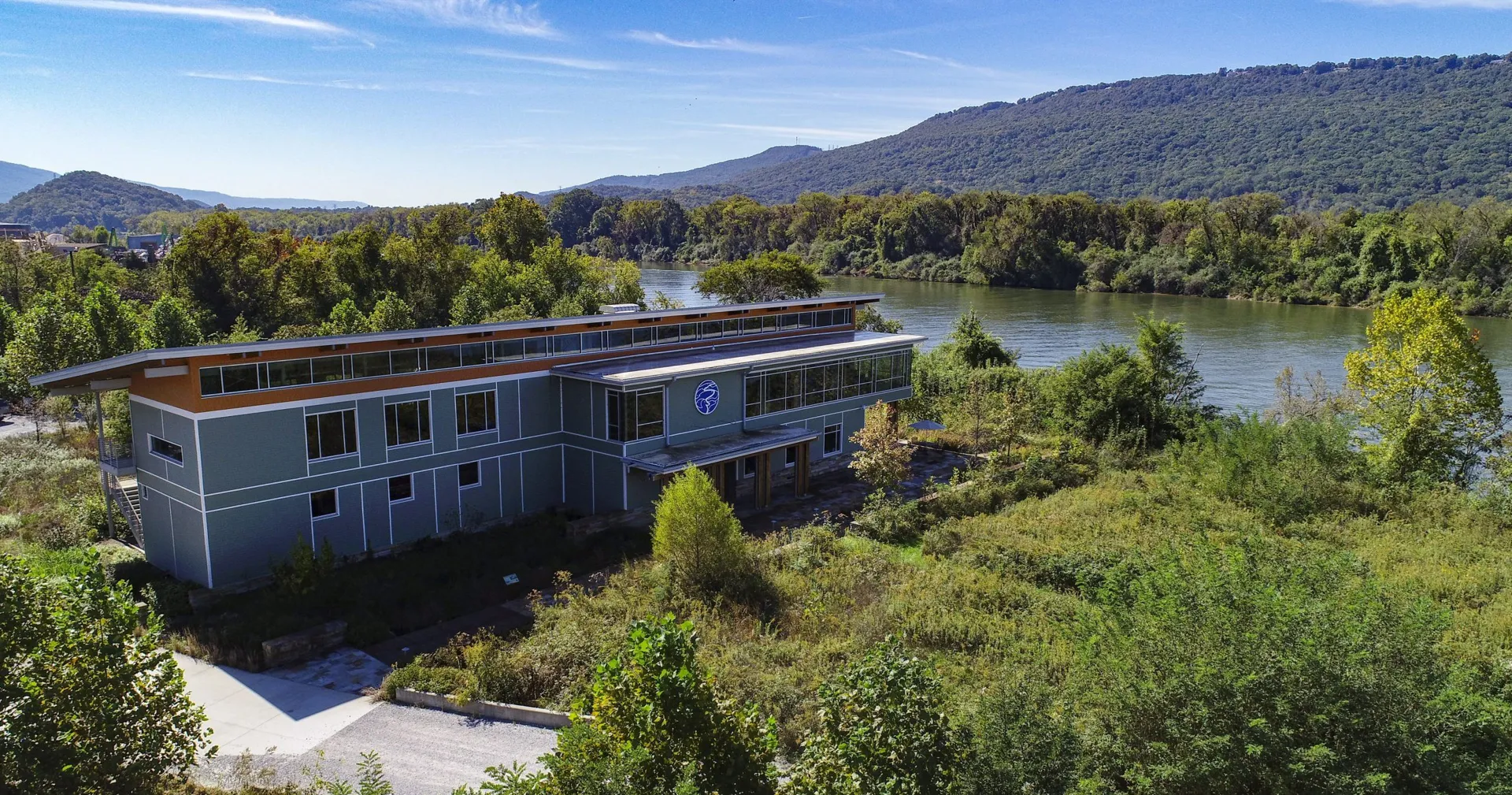On Oct. 27, 2016, freshwater science in the Southeast shifted into a higher gear as the ribbon was cut on the Tennessee Aquarium Conservation Institute’s flagship field station.
The Conservation Institute (TNACI), as an entity, existed long before this grand opening. However, creating a $6-million facility purpose-built to bring together the Aquarium’s conservation staff and resources represented the next stage in its mission to protect and preserve freshwater species.
“The Aquarium had always wanted to invest more heavily in our conservation efforts,” says Dr. Anna George, the Aquarium’s vice president of conservation science and education. “The Tennessee Aquarium had always focused heavily on the rivers and streams of the Southeastern United States. That made us unique among other aquariums, and this was a chance to elevate that even more.
“It was important to all of us that we not only displayed and celebrated these animals but also did something to protect them.”
Funding for this state-of-the-art science center on the banks of the Tennessee River was raised through a variety of sources. The Aquarium contributed about $2 million. The remaining $4 million was met through donations from private individuals and philanthropic contributions from companies and organizations such as the Benwood Foundation, Lyndhurst Foundation and BlueCross BlueShield of Tennessee.
From genetics, morphology and geospatial analysis labs to cutting-edge propagation and artificial stream systems, TNACI’s headquarters incorporates a suite of powerful tools with which its scientists have carried forward legacy projects as well as undertaking new research.
It was important to all of us that we not only displayed and celebrated these animals but also did something to protect them.
This 14,000-square-foot facility didn’t just house the means to pursue conservation-minded efforts, though. Those same ideals were baked into its architectural DNA.
The building employs a 6,000-gallon rain catchment system and repurposes its grey water to irrigate the native plants used in its landscaping. Designs for the facility also called for revitalizing a nearby wetland, which has since seen the return of Chorus Frogs and other native wildlife. Even decisions about seemingly insubstantial design elements were conservation-minded, such as leaving decorative stonework rough-finished to provide sheltering crevices for native reptiles.
These environmental-forward decisions ensured the science center’s existence had minimal impact on — or even benefited — the surrounding environment. This distinct, intentional design by Franklin Architects received numerous nods at the Building Recognition in Chattanooga (BRIC) Awards. A year after its opening, the science center also was awarded Leadership in Energy and Environmental Design (LEED) gold certification from the U.S. Green Building Council.



Conservation Convergence
Prior to the field station opening, TNACI resources were split between multiple facilities. Some scientist’s offices were located on the Aquarium’s downtown campus, while reintroduction programs were a 10-minute drive away at an off-site animal care facility.
The new science center improved the tools that were available to TNACI staff. However, perhaps even more importantly, it brought those resources together in a single location and expanded the possibilities for research and conservation.
The field station also has served as a meeting venue and flexible workspace for gatherings of freshwater stakeholders. Since coming into operation, the facility has hosted regional professional development workshops for educators developing freshwater science curricula, the annual meeting of the Southeastern Fishes Council, the Georgia Adopt-A-Stream Community Coordinator meeting and a summit of Southeastern malacologists (aka scientists who study mussels and snails).
Being able to serve as a convening point for planning and discussing conservation issues is an invaluable and often overlooked benefit of the new facility.
“That sounds pretty basic, but when you think about how hard it can be for people to find the right space to convene groups to facilitate important discussions for conservation action, it’s actually essential,” she says. “We’re a great team, but we can’t do everything ourselves.
“Finding the people who are invested in achieving similar goals and providing space for them all to come together to have those important conversations are some of the things I’m proud of accomplishing with the new facility.”
Making a Splash
TNACI staff weren’t long in putting their new tools to work. Within the first year of its opening, scientists tackled a wide range of projects, from surveying six threatened and endangered darter species in the Mobile River Basin and rescuing drought-imperiled Barrens Topminnows to radio-tagging Alligator Snapping Turtles in West Tennessee.
The pace hasn’t slackened from that breakneck start, and there have been even more opportunities to collaborate with partners, from local organizations to international scientific collectives.
Some of the highlights of the field station’s first five years of operation include:
- Mapping Southeastern biodiversity “hotspots” with the University of Georgia River Basin Center (learn more)
- Launching the Freshwater Information Network, an interactive database mapping the distribution of hundreds of Southeastern fish species (learn more)
- Successfully spawning Laurel Dace, one of the most-endangered fish in North America (learn more)
- Coordinating a virtual workshop to establish standards for freshwater microplastics research (learn more)
- Studying how continuing climate change could impact populations of salamanders and other vertebrates living in streams
- Joining other members of the Lake Sturgeon Working Group in celebrating the release of the 250,000th Lake Sturgeon into Southeastern waterways (learn more)
- Creating an interactive map of the world’s turtle populations as members of an international group of scientists (learn more)
- Working with global scientific partners to create a predictive model showing how a one-meter sea level rise could impact the world’s terrestrial wildlife
- Traveling to Kazakhstan to aid the search for the Syr Darya Shovelnose Sturgeon, a “lost” (presumed extinct) Central Asian fish (learn more)



Nationally, research and conservation of marine habitats and species or protection of species in Western states tends to get the lion’s share of funding. Consequently, resources to commit to the conservation of freshwater species — especially in the Southeast — are often comparatively slight, despite the region’s almost unparalleled abundance of freshwater life.
The Aquarium’s creation of a first-of-its-kind facility solely dedicated to the animals found in southeastern rivers, streams and springs filled a gaping hole and served to unify disparate conservation efforts, George says.
“People know and admire these large marine labs — such as Woods Hole [Oceanographic Institute] — places where scientists at all different levels are gathering to conduct collaborative research together in an atmosphere that promotes idea exchange,” she says. “That happens in many places for ocean science, but it wasn’t something we had seen for freshwater yet.
“We wanted to start building that in Chattanooga because of the diversity we have in our backyard. If you want to learn more about freshwater life, this is the place to be.”
An ‘Underwater Rainforest’
The Institute’s headquarters sits at the heart of what George has called “an underwater rainforest” of biodiversity in the Southeast. From its inception, the new field station was designed to serve as a nexus for regional freshwater science, one uniquely poised to study and protect the Southeast’s treasure trove of aquatic life.
Simply by existing, the field station stands as a monument to the Aquarium’s commitment to the cause of freshwater science. Visiting TNACI’s headquarters tends to open people’s eyes to the importance of healthy freshwater habitats and the biological richness of the Southeast’s intricate lacework of waterways.
“Every time I take somebody out to tour the facility, they’re just amazed at the work we’re doing,” says Aquarium President and CEO Keith Sanford. “Most of the time, they’re not even aware of the necessity of the kinds of projects we tackle. The need for a facility like ours is, unfortunately, a well-kept secret.”
As a nonprofit, the Institute can work across state lines with both governmental and non-governmental partners, from land trusts and local farmers to the U.S. Forest Service and Tennessee Wildlife Resources Agency. Together, they can determine how best to take their individual resources and combine them to greatest effect.
With each passing year, TNACI’s fellowships and assistantships also are gaining traction among universities. These programs are attracting the next generation of freshwater scientists, further cementing the Aquarium’s position as a torch-bearer for freshwater conservation, now and in the future.
“Students from all over the country, from California to New York to Puerto Rico, now come here to Chattanooga to study. That’s really what we want,” George says. “We want to put Chattanooga on the map so people know that: ‘If you’re interested in rivers, if you’re interested in protecting the animals that live in rivers, you come to Chattanooga to study at some point in your career.’ That’s our goal.”
If you want to learn more about freshwater life, this is the place to be.


Maintaining the Pace
On the eve of the headquarters’ fifth anniversary, TNACI scientists were far too busy to rest on their laurels or dwell nostalgically on past accomplishments.
In late summer, a team of aquarists and biologists donned wetsuits and snorkels in pursuit of Bridled Darters in Holly Creek in Northeast Georgia. Their evaluation of the population size and genetic health of this rare fish found in this pristine tributary of the Conasauga River will help determine whether the Bridled Darter warrants listing as an endangered species in years to come.
The wetsuits were barely dry, and the seine nets were still being rolled up in late September when they were called into action yet again. Working this time in the Tellico River near Tellico Plains, Tenn., TNACI scientists peered beneath the surface to pursue a larger (if still relatively small) quarry: the Tangerine Darter.
Topping out at more than seven inches long, Tangerine Darters are veritable Goliaths among darter-kind but, being fairly widespread, aren’t of any special conservation concern. However, this brilliantly colored, charismatic fish is lending a helping fin to the Cracking Pearlymussel, another imperiled Southeastern aquatic resident.
Like more than 70 percent of all Southeastern freshwater mussels, these brown, banded mollusks are endangered and at risk of extinction in the next 100 years. Mussels are especially sensitive to water quality, and their populations have seen a massive decline in recent decades caused by habitat degradation caused due to human activity.
And to pile on the obstacles they must overcome, the mussel life cycle requires the help of freshwater fish through a beautifully bizarre interaction that aids in their dispersal through rivers.
Mussels are fairly sedentary animals; with only one foot, they are not likely to set speed records. So female mussels that are ready to release their larvae, or baby mussels, draw specific species of fish in close through sometimes astonishing elaborate lures designed to mimic prey or a potential mate. Once near enough, mussels infect the duped fish with their larvae, whether by clamping around their target or releasing their offspring in an unavoidable cloud.
The larvae attach to the unwitting host’s gills, causing no harm but hitching a much-needed ride. After a few days’ ride, the larvae fall off and establish new mussel beds up or downstream from their parents.
And the fish species that Cracking Pearlymussels rely on to ferry their larvae?
Tangerine Darters.

Next year, TNACI will be providing Tangerine Darters to the Cumberland River Aquatic Center (CRAC), a Tennessee Wildlife Resources Agency mussel propagation and restoration facility near Nashville. The recently collected adult Tangerine Darters will overwinter at the field station before being spawned in the spring. Once mature, any offspring will be sent to CRAC to help propagate new Cracking Pearlymussels.
This work is being carried out during a crucial period in freshwater mussel conservation. In September, the U.S. Fish and Wildlife Service proposed a declaration of extinct status for 23 American animals, including nine mussel species, six of which are native to Tennessee. USFWS has listed another 51 mussel species in Tennessee as endangered or threatened under the Endangered Species Act.
And anything that imperils mussels inevitably has a ripple effect that ricochets up the food chain all the way to humans, says Dr. Dan Hua, CRAC’s manager and TWRA senior scientist.
“Freshwater mussels are ecologically and economically important,” Hua says. “As filter feeders, they ‘clean’ the water by removing suspended particulates, detritus and harmful elements.
“In addition, freshwater mussels embed themselves into the substrate and have little capacity to move long distances. Therefore, they are recognized as useful indicators of water quality.”

Carrying On
In addition to working in newly forged partnerships, TNACI continues its work on long-term projects to protect and restore iconic Southeastern species, such as the Southern Appalachian Brook Trout and Lake Sturgeon.
This spring, the Aquarium and its partners began stocking a new Appalachian stream with Brook Trout. Once thriving in the Southern Appalachians, these beautiful stream fish were ousted from the vast majority of their range in part due to competition from introduced Rainbow and Brown Trout. Poor logging practices choked the waters with silt and made the streams inhospitably warm for native trout. Scientists also remain concerned about the effect of changing temperature and precipitation patterns.
On the last day of summer, a team from TWRA hand-delivered ten new adult “Brookies” to the field station. These fish, collected from Brookshire Creek in the Cherokee National Forest, will add their unique genetics to the juveniles raised at TNACI and released into the wild each spring.
TWRA’s effort to bring the Southern Appalachian Brook Trout back to its historic waters began in the 1980s. The Aquarium began contributing to the propagation and release efforts in 2012. The decision to shift to a new stream system this year was made because previous release sites now host self-sustaining populations.
“That shows that our reintroduction program has been successful,” says TNACI Reintroduction Biologist Sarah Kate Bailey. “Adding new broodstock to our current adult trout population ensures we will be adding genetic diversity to these streams, which is a key component of a healthy population.”
The Aquarium’s effort to restore the Lake Sturgeon to the Tennessee River is even more of a marathon undertaking. On Oct. 7, the Aquarium and the other Lake Sturgeon Working Group members celebrated the 22nd year reintroducing juvenile Lake Sturgeon to their native river systems in the Southeast.
With winter-bare branches still scraping the skies in central Wisconsin this May, TNACI scientists made the 800-mile drive to the Wolf River to help collect and strip eggs and milt from wild spawning Lake Sturgeon. These eggs were fertilized and transported to hatcheries. Weeks later, the tiny juveniles were sent to the Conservation Institute to spend the summer growing to about six inches on a diet of blood worms.
The Wolf River’s still-healthy population of Lake Sturgeon stands in stark contrast to the Tennessee River, from which Lake Sturgeon had disappeared by the 1970s due to a combination of overfishing, river damming and low water quality.
This year’s release of about 650 juvenile Lake Sturgeon are the result of the Wolf River spawning and are welcome transplants to the Southeast. Their release into the waters of Watts Bar Reservoir in Kingston, Tenn., marks the latest chapter of a project that started in the mid-1990s, when improved conditions in the Tennessee River suggested a restoration was possible.
In all, more than 250,000 Lake Sturgeon have been returned to the Tennessee River and other Southeastern waterways since 2000. Of these, more than 30,000 — about one in nine of those released — were raised by the Aquarium.
More to Do
TNACI’s new headquarters has been the site of many conservation firsts and notable success stories during its first five years. But conservation, especially of freshwater species, is a constant game of running to keep up. There’s always more to do and new goals to pursue.
In recent years, many threats to the health of freshwater ecosystems, as well as the planet at large, have made clear that TNACI’s work is far from finished, George says.
“While I’m proud of the work we’ve accomplished, there’s also a lot that feels left undone, and it feels even more important now,” she says. “During the pandemic, people became much more aware of how crucial nature is to our emotional and physical health. That led to a growing awareness of the importance of our work.”
But even as the pandemic inspired many, it also led to an increased consumption of single-use items like takeout packaging and cutlery, masks and gloves. A study soon to be published in the Dec. 15 volume of Chemical Engineering Journal found that disposable masks are estimated to have generated 3.86 million tons of plastic waste in 2020 alone. Meanwhile, the droughts, wildfires, and hurricanes that have affected so much of the country have brought heightened concern about the challenges ahead from climate change.
As TNACI’s new headquarters begins the march to its 10th anniversary, then, more resources and research hours will be spent understanding how troubling trends like the increase in microplastic debris and a changing climate will impact freshwater species.
“We’ve achieved a lot in the last five years,” George says. “But now, it feels more urgent to work even harder over the next five to counteract some of these alarming trends. I am grateful for the firm foundation to our work so we can meet the environmental challenges that await us.”
I am grateful for the firm foundation to our work so we can meet the environmental challenges that await us.
